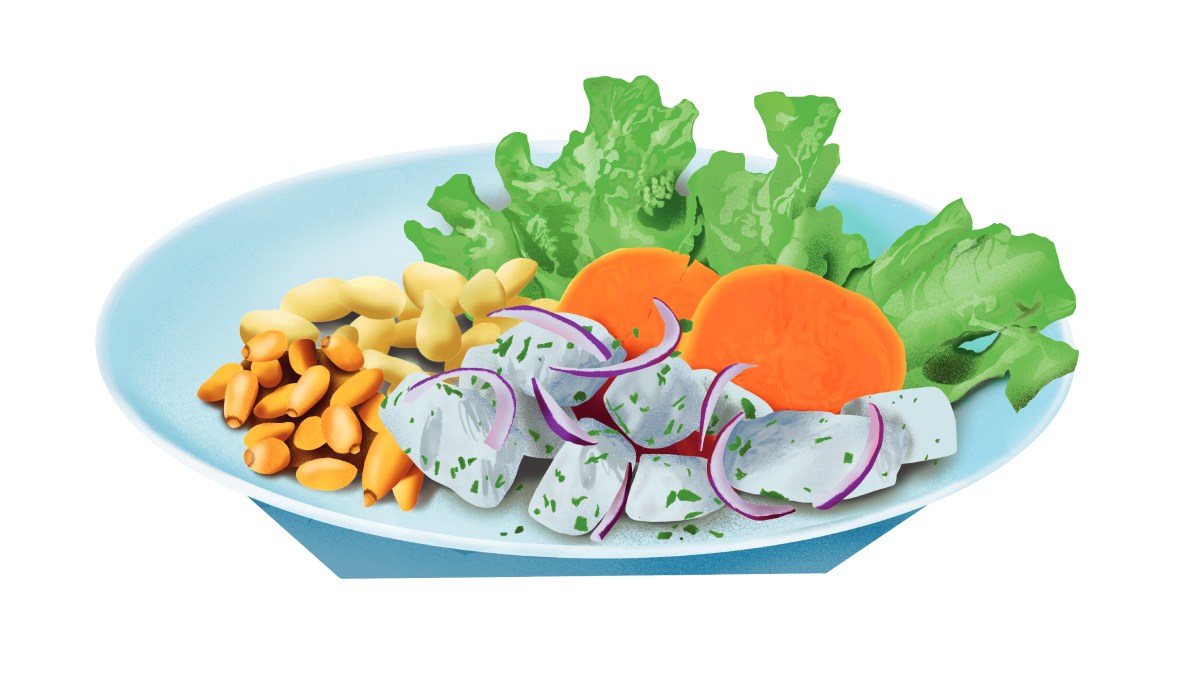Click here to read the Spanish version.
To find the origin of ceviche, one must travel to the north of pre-Columbian Peru, to its coastal deserts. On the arid coast beaten by the waves of the Pacific Ocean lived the tenacious Mochicas, who almost two thousand years ago were eager to wrest something from the soil of their ancestors. They were skilled engineers who dug canals in an almost Martian desert to irrigate their crops. They erected temples and adobe pyramids. They also boarded picturesque boats with short pointed prows, made from the leaves and stems of reeds.
Conceived to tame the sea in the caballitos de totora -that was the name of these peculiar boats- the sturdy fishermen would take the fish to land. There they cooked it with tumbo, a slightly acidic native fruit, with whose juice it was bathed.
It is taken for granted that along the coasts of Tumbes, Piura, Lambayeque and Lima, the natives were in the habit of eating raw fish. We know this thanks to the chronicler Francisco de Xerez, who accompanied Pizarro in his conquest of Peru. The polemic colonial look was accompanied by the gastronomic observation: “They are dirty people, they eat meat and fish, all raw; they eat corn cooked and toasted”. He was referring to the Incas, who macerated fish with chicha de jora, a fermented drink made from malted corn. It was the favorite drink of the local nobility, with which they toasted in honor of the Sun (Inti). The Mochicas had disappeared centuries before, due to the rains and droughts that devastated the arable land and their populations.
With the Spaniards came onions and bitter oranges. Also lemons. There is a theory that four Moorish cooks arrived with Pizarro. The ceviche would come from the escabeche and it would be the Moorish servants of the viceroyalty who adapted the formula, substituting the vinegar for lemon, together with coriander and onion, which came in the pantries of the Spanish ships, in addition to the chili bell pepper.
All this is a source of conflicting conjectures. The word ‘ceviche’ descends from Andalusian Arabic. But it is not the only hypothesis in dispute. Some, more comical, say it would be the phonetic adaptation of the annoyed exclamation of an Anglo-Saxon who cursed because of the high level of spiciness of his dish. “Son of a bitch!”.
Others say that it comes from ‘cebo’, the small pieces of fish used for fishing or small meals. Or even from the Quechua siwichi: fresh or tender fish. The enigma is in the hands of philologists as well as gourmets. The existence, this time proven, of Catalina Cuevas, the cook of Inés Muñoz, Pizarro’s sister-in-law, who brought wheat and olives to Peru and learned Quechua, and who learned to cook with the ingredients she found in the New World, gives an idea of the incipient fusion of cuisines on both sides of the ocean.
We would have to wait several centuries to find the first recipe for ceviche. In 1866, the writer and journalist Manuel Atanasio Fuentes, who documented Lima life in the 19th century, wrote in Lima: apuntes históricos, descriptivos, estadísticos y de costumbres that “it consists of small pieces of fish, or shrimp, which are tossed in sour orange juice, with lots of chili and salt; they are kept like this for several hours, until the fish is impregnated with chili, and almost cooked by the caustic action of this and the sour orange”.
The canon of fish, red onion, chili, salt and lemon has been expanded with regional versions
The secret of ceviche lies in the lemon, which coagulates the proteins in the muscle tissue of the fish, which is more tender than that of the meat, as McGee describes in his indispensable The Kitchen and Food. The acid causes the translucent, gelatinous tissue “to become opaque and firm, but more gently than if heated and without the change in flavor caused by high temperatures.”
But in that nineteenth-century Peru, “seviche”, as it was spelled in vogue, was one of the so-called “picantes”: dishes based on strongly seasoned meat or fish. One of its virtues was the pleasure of spending a few moments gasping for the irritation of the digestive system. To mitigate the burning of the chili, people drank chicha. These hot peppers were street food in Lima, sold by blacks, or from the so-called picanterías, run by Indian women. It was held in low culinary esteem due to its popular condition. Today the lemon barely bathes the fish for a few moments, but back then the fish was macerated for many hours in it, due to the lack of means to preserve the cold chain. This has also influenced the fact that ceviche is a daytime dish. In the past, fish or seafood was only kept fresh during the day and the custom was to consume it before sunset, the Inti of the Incas. That “seviche” was the one that adorned the mythical bar of Lima’s Café Can Cán, next to the Plaza Grande, where the steps of the petimetres and the coachmen converged.
Today the caballitos de totora are used for surfing on the northern beaches and the cultivation of the tumbo has dwindled. But the canon of fish, red onion, aji limo, salt and lemon has expanded with regional and cooks’ versions. Of shrimp in Arequipa. Of octopus, due to the Japanese Nikkei influence, which contributed to perfecting the cuts of fish. Of black shells in Tumbes, of grouper in Piura, of salted and sun-dried guitarfish in Lambayeque, or of paiche or maiden fish, Amazonian fish, in the jungle. From the picanterias to the high gastronomic temples. Ceviche shines all over the world as a cultural heritage and emblem of Peru.
Illustration: Leonardo Berbersí.

